Common menu bar links
Institutional links
Diseases & Conditions
Health & Safety
Research & Statistics
Agency Information
Search Box
E-mail this page
Progress Report on Cancer Control in Canada
[Previous] [Table of Contents] [Next]
Cancer Control in Canada
Where have we been, and where are we going?
In Canada, with few exceptions, the provision of cancer services is a provincial responsibility. Most provincial cancer control programs have developed within provincial cancer agencies. Over time, these agencies have expanded from running specialized treatment facilities to assuming major responsibility for various aspects of cancer control, such as organized breast cancer screening, in their respective provinces. Cancer prevention, and to a lesser extent supportive/palliative care, have traditionally received less attention.
The population health approach
In recent years, federal and provincial health ministries have adopted a population health approach in their efforts to prevent cancer and other chronic diseases, including heart disease, respiratory illness and diabetes. The population health approach aims to improve the health of the entire population and to reduce health inequities among population groups by taking action on a broad range of complex and interrelated “health determinants” that have a strong influence over health. Population health initiatives spearheaded by federal and provincial governments include those aimed at tobacco control, dietary change and obesity reduction, all of which have major implications for the battle against chronic diseases in Canada.
Integration of cancer control activities in Canada
Cancer control is too complex and broad a challenge for any single jurisdiction or organization to tackle on its own. There has therefore been a tendency in recent years towards integration of cancer control activities in Canada. This trend finds support from the World Health Organization (WHO), which has proposed that cancer control should be managed within the context of a National Cancer Control Program. The WHO defines such a program as "designed to reduce cancer incidence and mortality and improve quality of life for cancer patients, through the systematic and equitable implementation of evidence-based strategies for prevention, early detection, diagnosis, treatment and palliation, making the best use of available resources."
Toward a national cancer control program
In 1990, Health and Welfare Canada and the Canadian Cancer Society co-sponsored a Task Force that developed a plan for a National Cancer Control program in Canada similar to the model proposed by the World Health Organization. In 1999, Health Canada began working in partnership with the Canadian Cancer Society/National Cancer Institute of Canada and the Canadian Association of Provincial Cancer Agencies and other stakeholders to develop the Canadian Strategy for Cancer Control (CSCC).
The CSCC, which now includes representatives of all the major stakeholders in cancer control in Canada, emphasizes the need to plan for the projected increase in the burden of cancer care in Canada resulting from population increases and the aging of the population. The Strategy has identified the following priorities: prevention, guidelines and standards, human resources, research and psychosocial/supportive/rehabilitative, and palliative care.
Further integration of cancer control activities is also evidenced by the creation of the Canadian Association of Provincial Cancer Agencies (CAPCA). CAPCA represents provincial/territorial cancer agencies and programs engaged in cancer control. It helps support the coordination of cancer control matters, and acts as a voice for organized cancer control development and program delivery. Integration across cancer sites is also occurring at the patient advocacy level, as witnessed by the 2002 creation of the Canadian Cancer Advocacy Network (CCAN).
How does Canada compare to other countries?
Nearly one-half of the 167 countries contacted by the World Health Organization in a 2001 survey indicated that they had a cancer control policy or plan. However, relatively few of these countries have comprehensive control programs that include prevention, early detection, treatment and palliative care. In the Americas, Canada is one of only five countries that have drafted comprehensive strategies; the others are Brazil, Chile, Columbia and the United States.
Canada versus other developed countries
The International Agency for Research on Cancer estimated incidence and mortality rates for countries around the world for the year 2000. Overall cancer incidence rates for males are slightly lower in Canada than in the U.S., largely because of lower prostate cancer rates. However, overall mortality rates in males are almost identical in the United States and Canada. In general, incidence rates in males are slightly higher in Canada than in developed countries as a whole, but mortality rates are slightly lower.
Incidence and mortality rates for females were generally higher in Canada than in other developed countries, with the exception of the United States, which had rates that were generally comparable to those in Canada.
Canada compared to developing countries
As with other developed countries, male and female incidence and mortality rates in Canada were much higher than those noted for developing countries. In addition to reflecting a true difference in underlying risk, lower rates in developing countries may also reflect a lack of cancer identification and registration resources in these countries.
Cancer incidence and mortality in Canada
Data sources
In Canada, some provincial cancer registries have been collecting cancer incidence data since the 1930s. A national cancer incidence reporting system was initiated at Statistics Canada in 1969 and was developed into a patient-oriented cancer registry in 1992. Currently, various organizations have been collecting cancer-related information, including provincial and territorial cancer registries, Statistics Canada, Health Canada and the Canadian Institute for Health Information.
To improve coordination of data collection and provide timely information for cancer control planning and monitoring, a population-based surveillance system for evaluating health determinants, management programs, and the outcomes of cancer is being developed through the Canadian Cancer Surveillance Alliance. The system will be instrumental in the development of preventionbased population health policies and strategies to reduce the burden of cancer in Canada.
New cases (Incidence)
- In 2004, an estimated 145,500 new cases of cancer will be diagnosed in Canada; 74,800 in males and 70,700 in females.
- For the period 1990–2000, the number of new cancer cases increased by 2.5% per year.
- The most common types of cancer are lung, prostate, breast and colorectal cancer. These four cancers combined account for over 56% of new cases of cancer.
- The most frequently diagnosed cancer in women is breast cancer and in men, prostate cancer.
- Cancer remains mainly a disease of older Canadians. In 2000, 58% of all new cancers were diagnosed among Canadians 65 years of age or older. By contrast, only 1% of new cases occurred among Canadians under the age of 20.
- For the period 1996–2000, incidence rates of all cancers increased gradually by age at diagnosis, beginning in middle age and increasing more rapidly after age 55, particularly in males (Figure 1).
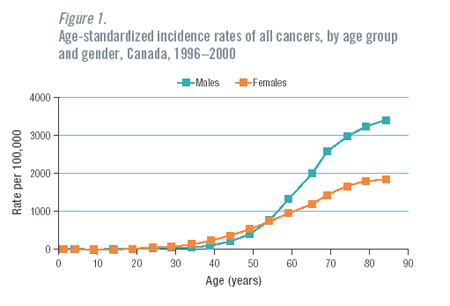
- Rates at ages 35–54 years were higher in females than males, largely reflecting the impact of breast cancer at these ages.
- In 2000, 62,670 Canadians (33,358 males, 29,312 females) died from cancer, representing 29% of all deaths occurring in Canada during that year. The largest proportion of cancer deaths for both men and women were from lung cancer (29% and 22% of all cancer deaths respectively).
- Breast cancer accounted for 17% of all cancer deaths among women, while prostate cancer accounted for 11% of all cancer deaths among men. Colorectal cancer accounted for 13% of both all male and all female cancer deaths. The top four cancers combined accounted for more than 50% of all cancer deaths in 2000 for both men and women.
- Incidence rates for all cancers in males peaked in 1993, declined until 1996, and have been relatively stable since (Figure 2). In contrast, incidence rates for females for all cancers combined have slowly increased over the last 15 years, reflecting large increases in lung cancer incidence. Incidence rates for most individual types of cancer are declining for both men and women.
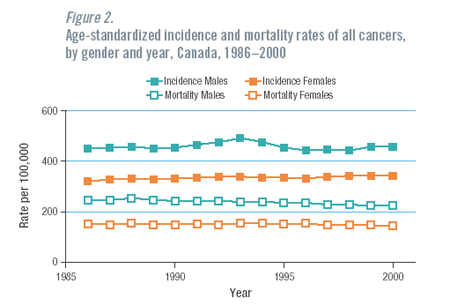
- Breast cancer incidence rates in women increased from the mid-1980s until the early 1990s, but have been relatively stable since (Figure 3). Increases in mid-1980s reflect the widespread adoption of mammography screening during this period.
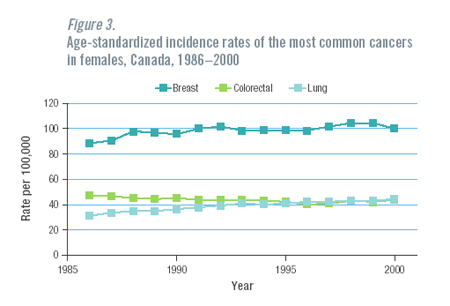
- The sharp increase in prostate cancer incidence in the early 1990s (Figure 4) corresponds to the introduction of opportunistic Prostate Specific Antigen (PSA) testing in Canada.
- Although incidence rates for most cancers are declining or stable, two exceptions are non-Hodgkin’s lymphoma and thyroid cancer. While still relatively uncommon, non-Hodgkin’s lymphoma incidence has increased steadily since 1986 (Figure 5). The incidence of thyroid cancer has increased dramatically in the past decade, particularly among women (Figure 6), who are now affected by thyroid cancer about three times more often than men.
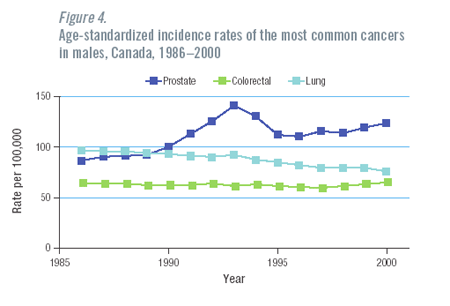

Deaths
The mortality rates for all cancers have declined among both men and women since the late 1980s, from a high of 195.7 per 100,000 in 1988 to 180 per 100,000 in 2000 (Figure 2). This decline is due largely to decreases in mortality rates from breast, prostate and colorectal cancer and lung cancer in males (Figures 7 and 8).
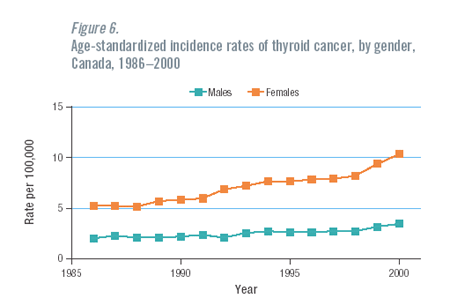

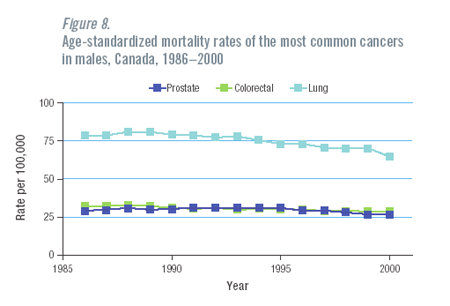
While lung cancer mortality rates among men are still high, they have declined significantly since the mid-1980s, reflecting a decrease in male tobacco consumption since the mid-1960s (from 60% in 1965 to 23% in 2002). However, female lung cancer mortality rates continue to increase.
Improved treatment regimens have led to declines in mortality from testicular cancer and Hodgkin’s disease, while screening has contributed to a steady decline in cervical cancer mortality.
Childhood cancer
Cancer in children is rare, accounting for only about 1% of all cases. From 1996–2000, an average of 1,289 new cases of cancer were diagnosed per year in children and youths aged 0–19 years. Incidence rates are highest among young children (aged 1–4 years) and adolescents (aged 15–19 years). The overall incidence of childhood cancer has remained relatively stable since 1985, varying from 15.1 to 16.8 per 100,000 children (Figure 9).
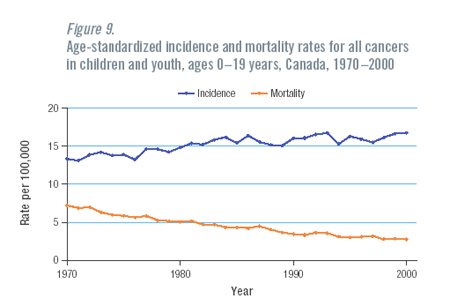
The type of cancer diagnosed in children and adolescents differs considerably from adult cancers. While most adult cancers are carcinomas (i.e. cancers that arise in glands and tissues which line organs such as the colon), cancers in children are mainly leukemias (arising from the bone marrow), brain tumours, lymphomas (arising from lymphatic tissues) and sarcomas (cancers found in bones, muscles and connective tissue in certain organs). Leukemia is the most frequent type of cancer diagnosed in children, accounting for 26% of new cases in the period 1996–2000. Cancers of the brain and spinal column are the second most common type, representing 17% of all new cancers, followed by lymphomas, at 16%.
There has been a dramatic decline in childhood cancer mortality (Figure 9). This has been due primarily to treatment advances leading to improved survival, particularly for childhood leukemia. Currently, 80% of children with leukemia are still alive five years after diagnosis, while 40 years ago, survival was uncommon. There has also been improved childhood survival for lymphomas and kidney cancer. In 2000, 218 children and adolescents (aged 0–19 years) died from cancer, representing 6% of all deaths that occurred in that year for this age group.
Potential Years of Life Lost (PYLL)
In 2000, cancer was the leading cause of premature mortality in Canada. The other two leading causes of PYLL were circulatory and respiratory diseases. Among children, cancer ranked as the sixth leading cause of PYLL.
Lung cancer accounted for 26% of PYLL for all cancers (Figure 10), reflecting the fact that lung cancer is more common and has a lower survival rate than other cancers. Among men, lung, colorectal and prostate cancer together accounted for 48% of PYLL for cancer. For women, 52% of the PYLL is due to lung, breast and colorectal cancers.
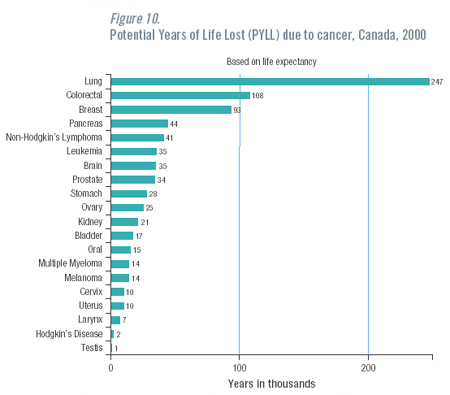
Even though more men die from cancer each year than women, the PYLL due to cancer is higher for women (494,000 years) than for men (460,000 years). This is due primarily to differences in PYLL for breast cancer (93,000 years) compared to prostate cancer (34,000 years); breast cancer occurs at a relatively younger age in women than prostate cancer in men. Some cancers are associated with low PYLL. For instance, Hodgkin’s disease has a PYLL of 2000 years, reflecting a cancer that is less common and relatively curable.
Variations in provincial and territorial cancer rates
Incidence
Overall, cancer incidence rates are highest in the east, and lowest in the west (Figure 11). The exception is Newfoundland and Labrador, where low rates reflect the under-reporting of certain types of cancer. Women in the N.W.T./Nunavut had the highest rates of lung cancer, almost double the rate in all other provinces/territories (Figure 12). Women in Alberta, Saskatchewan and Ontario had the lowest lung cancer rates. The highest rate of colorectal cancer was also among N.W.T./Nunavut women, while women in the Yukon had the lowest rates. N.W.T./Nunavut women had the lowest rate of breast cancer while the highest rates were found among women in Prince Edward Island, Nova Scotia, Manitoba and the Yukon.
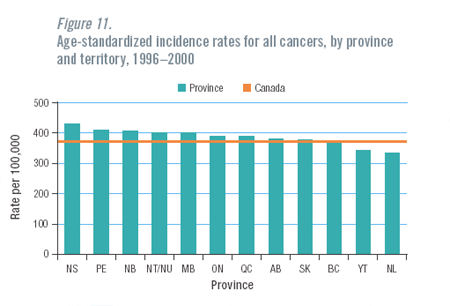
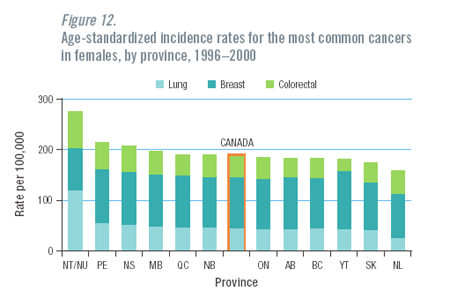
Men from the N.W.T. and Quebec had the highest rates of lung cancer while British Columbia, Alberta and Saskatchewan had the lowest rates (Figure 13). Prostate cancer rates were highest in Prince Edward Island and New Brunswick and lowest in the N.W.T./Nunavut and the Yukon. Men in N.W.T./Nunavut had significantly higher colorectal cancer risks.
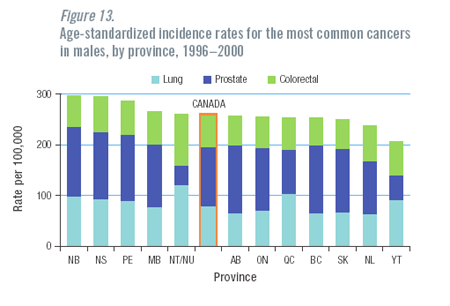
Mortality
Mortality rates show similar provincial/territorial variations (Figure 14). The highest mortality rates from cancer occurred in the N.W.T./Nunavut for women and in Quebec and the N.W.T./Nunavut for men, reflecting high lung cancer mortality rates (Figures 15 and 16). The N.W.T./Nunavut also had the highest mortality rates in Canada for colorectal cancer, but the lowest rates for breast and prostate cancer. Overall, cancer mortality rates in British Columbia, Alberta, Saskatchewan and Ontario were lower than the national average, while Atlantic provinces were higher than the national average.

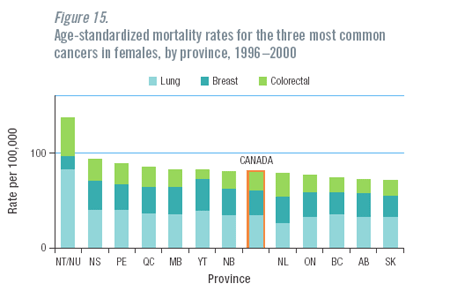
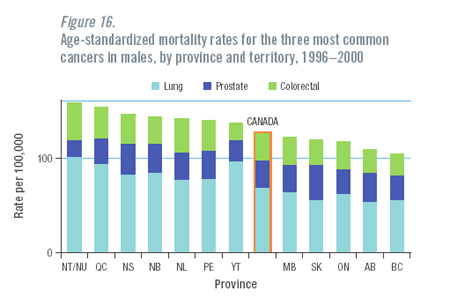
[Previous] [Table of Contents] [Next]
